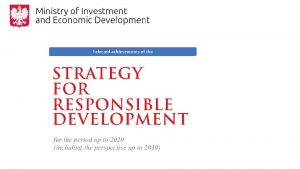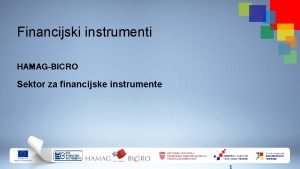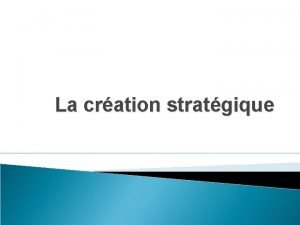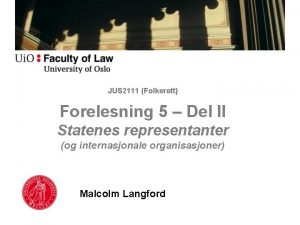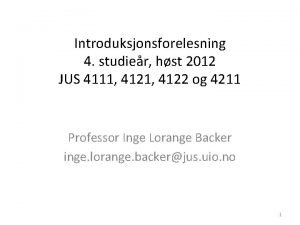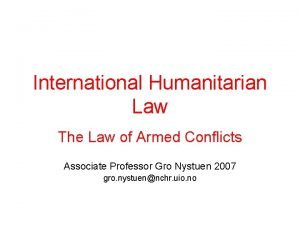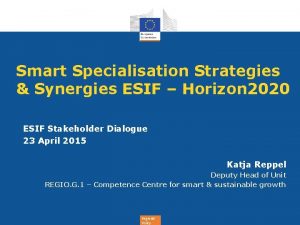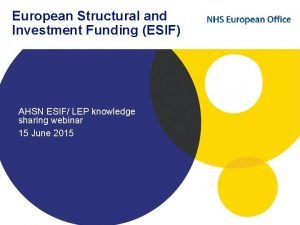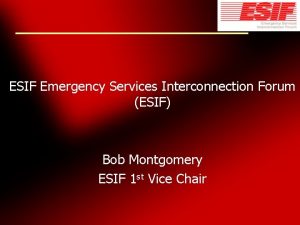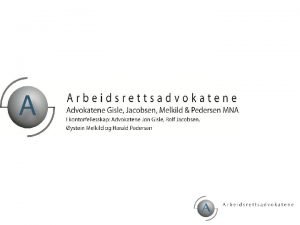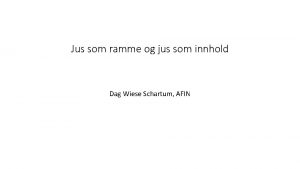Developing synergies JUs and ESIF FCH Cities and















- Slides: 15

Developing synergies JU’s and ESIF -FCH Cities and Regions initiative BART BIEBUYCK Brussels, March 7 th 2018

Why the FCH JU works with Regions EU perspective REGIONS perspective 1. Contribute to EU social, economic and environmental policies 1. Increase awareness of emerging FCH technologies 2. Increase outreach of EU bodies 2. Support local initiatives and strategies 3. Get closer to citizens by enhancing local collaboration 3. Catalyse local project concepts and help start planning INDUSTRY perspective 1. Tap into new market opportunities 2. Potential for demand aggregation 3. Helps define product & development FCH Regions and Cities Initiative 2

OBJECTIVES OF THE STUDY Support regions in assessing various FCH applications Identify and maximize the use of regional and Europe-wide funding/financing options Develop roadmaps and concepts for the months after the study, prepare and implement deployment projects from 2018 Support the participating regions/cities to engage their stakeholders 3

88 Regions/Cities from 22 countries representing ca. one quarter of Europe participate in the study Belgium >Flanders >Pom West. Vlaanderen United Kingdom >Swindon and Wiltshire >Aberdeen >Birmingham >Cornwall >Dundee >Fife >Leeds France >Auvergne Rhone-Alpes >Bourgogne-Franche-Comté >Centre-Val de Loire >Grenoble >Grand Dole >La Roche sur Yon >Normandie >Occitanie-Phyrenees >Orléans >Pays de la Loire >Pays de St Gilles Portugal >Torres Vedras >Médio Tejo Netherlands >Assen >Drenthe >Emmen >Groningen >London (Greater London Authority) >Newcastle >Orkney Islands >Oxfordshire >Perth and Kinross >Manchester >Tees Valley Spain >Aragon >Barcelona >Cantabria >Castilla – La Mancha >Murcia >Port of Valencia >Puertollano >Valladolid Italy >Lazio >South Tyrol >Favignana Austria >Tirol >Torino >Venice >Toscana Norway >Akershus >Møre og Romsdal >Oppland County Municipal >Sogn og Fjordane Iceland >Reykjavik Sweden >Gavleborg >Mariestad Finland >Kokkola Denmark >Guldborgsund >Lolland Estonia >Tallinn Latvia >Riga Germany >Baden. Württemberg >Bremerhaven >Hamburg >Hy. Cologne. Hydrogen Region Rhineland >Kreis Steinfurt >North Rhine. Westphalia >Heide region >HYPOS (East Germany) >Recklinghausen >Saxony-Anhalt Slovenia >Velenje Czech Republic >Trutnov Croatia >Split-Dalmatia County Romania >Constanta Bulgaria >Bulgarian Ports >Sofia Greece >Alimos >Agia Paraskevi >Ierapetra >Kozani >Milos >Vrilissia >Kalymnos >Heraklion >Western Macedonia >Papagoou-Halargos >Region of Crete 4

Over 50 FCH industry players at present FCH 5

As a result of Phase 1, motivation to pursue FCH deployments remains high whereas some perceived challenges could be relieved Comparison of selected answers from 1 st and 2 nd 1) self-assessment Main reasons for pursuing FCH applications [%]2): Main obstacles and challenges [%]3): Reduce local emissions of greenhouse gases Reduce emissions of pollutants Create additional employment opportunities Improve the image as "green" Foster industrial innovation and development Reduce primary energy consumption Increase "smart city" activities Increase the usage of local hydrogen supply Reduce local emissions of noise Lack of funding / financing Insufficient viability of the business case Focus of Phase 1 Lack of hydrogen supply Complexity of permitting and authorization procedures Lack of industry stakeholder support Insufficient technological readiness Focus of Phase 1 Regulatory barriers Lack of political backing and buy-in 2 nd survey 1 st survey Perceived obstacles/challenges addressed in Phase 1 have been considerably reduced 1) Percentage share of participants who set either 3, 4 or 5 points on a 5 -point Likert Scale (5 = very important) 2) "What are your region's/city's main reasons for pursuing FCH applications? How relevant and important are typical drivers for FCH technologies to you, also compared to one another? " 3) "Within your region/city, which hurdles and challenges currently pose obstacles to the deployment of FCH applications? " 6

The FCH applications in scope are heterogeneous – Different tech. readiness, economic competitiveness and deployment complexity Evaluation results of 10 FCH applications 1 on seven key dimensions 1 TRL 2 Economic competitiveness 3 Environmental benefits 4 Unique selling propos. 5 Ease of deployment 6 Direct pro -curement 7 Visibility as "showcase" (Urban) Buses Transport Cars applications Delivery vans Heavy-duty trucks Trains Port operations Power to H 2 Stationar y applications H 2 injection into gas grid Residential m. CHP Off-grid power High Medium Low 1) Please note that the selection only contains the ten top-ranked applications as stated by the Regions and Cities in the initial self-assessment survey (June 2017) 2) Results differ depending on location, time horizon, benchmark technology as well as specific use case under consideration 7

Considerable future FCH projects are planned all over Europe (20172022), especially in Central Europe, Nordics and UK Survey results – Total estimated project volume 1) [m EUR] – APPROXIMATION 9 7 Benelux (5 regions/cities) Nordics + LVA (8 regions/cities) 101 UK (10 regions/cities) 13 Central Europe (10 regions/cities) 131 France (9 regions/cities) 4 South East Europe (15 regions/cities) Iberian + Italy (10 region/&cities) 2 11 13 20 2012 -2017 -2022 Countries with regions that participated in the survey 1) Overall project volume in each geographic cluster calculated as sum of all aggregated project volumes of regions/cities; # of regions/cities refers to those with answers to this question Source: FCH 2 JU, Roland Berger 8

Urban buses, cars, delivery vans, trains and garbage trucks are the most relevant applications for participating Regions & Cities Survey results on most relevant FCH applications 1) Preliminary indicative deployment volumes [# units] Buses Cars H 2 production Garbage trucks Trains Delivery vans H 2 -to-X H 2 into gas grid Grid services Bikes Heavy-duty transport Ships Commercial buildings Port ops. equip. Sweepers Boats Ferries Resid. use/ m. CHP Back-up power Off-grid power Material handling Airport handling equip. Industrial use case Scooters Construction equipment Aircraft Gen-sets Trains Buses Cars Delivery vans Garbage trucks Sweepers Bikes Scooters Ferries Boats Ships Port operations equipment Commercial buildings Industrial use cases Off-grid power H 2 production H 2 -to-X H 2 into gas grid Grid services The survey asked participating Regions & Cities which applications were most relevant to them for deployment in the next 3 to 5 years Regions & Cities were also asked to indicate potential deployment volumes for each top 3 application selected in the next 3 to 5 years 3, 600 1, 217 Highly p potenti reliminary – I n particip al as outlined dicative by surv ants wh ey e been p re figures hav rovided e 1) Ranking according to total points collected for each application based on a Top 1, 2 or 3 priority ranking by each survey participant 9

The agreed-upon application framework for Phase 2 comprises five top mobility applications and H 2 production as cross-cutting topic 1 Application scope for Phase 2 based on consolidated ranking Five FCH mobility applications as focus for detailed business cases > Buses > Cars > Delivery vans > Garbage trucks > Trains 3 2 Selected further applications as focus for technology development dialog platform > Heavy-duty transport > Maritime applications > Commercial buildings (Green) hydrogen production as cross-cutting topic for both consideration in detailed business cases as well as development of project concepts and roadmaps in Phase 2 of the project – for the latter also including a view on secondary applications (depending on interest in the coalition) 10

The coalition will be divided into two tiers – Target outputs are valley concepts, roadmaps and project ideas, market/funding intelligence Tier-based project coalition Tier-specific project outputs 1 Tier 1 "FCH valleys" ~ 25 Regions & Cities Overall project outputs A 1 FCH Valley Concept Region A A 2 Sub-projects by application ~ 90 Regions & Cities Market intelligence, e. g. volumes Application 1 (EU) funding priorities for FCH B 1 FCH Roadmap City B "1 st Tier 2 FCH projects" ~ 70 Regions & Cities 2 B 2 "1 st project" concepts by app. Regions & Cities develop, RB facilitates & supports in the process, FCH industry assists with experience and expertise 11

Regions & Cities are looking to implement the concrete next steps of a long-term development towards widespread use of FCH market development perspective from the FCH JU Regions & Cities Initiative Key learnings from the project so far • Large interest of Regions & Cities to engage in FCH deployment projects • Many participants see H 2 to play a central role in sector coupling and in a broad range of application areas • To initiate this development, a group of participants aims to realise "H 2 Valley" projects covering the entire H 2 value chain and including different kinds of applications • Besides this, levels of ambition, experience and concreteness of plans are highly heterogeneous, but many regions and cities aim at realising the concrete next steps • Main challenges are lack of commercial availability of relevant products and lack of funding for the cost premium 12

ESIF 2014 -2020 regional eligibility – budget earmarked for Clean Urban Transport (by region) Structural Funds eligibility Clean Urban Transport infrastructure and promotion (including equipment and rolling stock) Cohesion Fund eligibility (15 MS) Cohesion Countries (#15) (i. e. 80%) + Spain and Italy (i. e. 93%) • • http: //s 3 platform. jrc. europa. eu/esif-viewer FCH JU to work on synergies and complementary calls with ESIF Bottom-up (Regions) Vs. Top-down (Member States) approach Huge discrepancy between the level of EU funding available Regions in the EUcc 15+2 well placed to deploy Clean Urban Transport projects under ESIF budget 13

Funding and Financing Navigation Tool One of the various practical outputs of the FCH Regions and Cities Initiative The cockpit of the funding and financing navigation allows you to set different filters to identify potential sources for local FCH projects As search result, comprehensive fact sheets summarize information on the individual funding programmes Identify and maximize the use of regional and Europe-wide funding/financing options 14

Bart Biebuyck Executive Director bart. biebuyck@fch. europa. eu For further information www. fch. europa. eu www. hydrogeneurope. eu www. nerghy. eu @fch_ju Fch-ju@fch. europa. eu FCH JU
